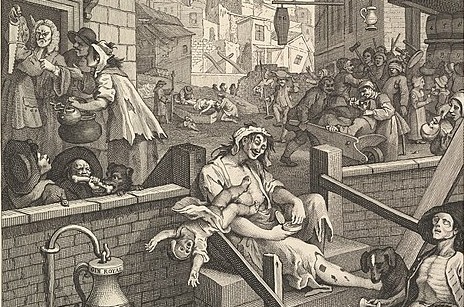Post
EVENT CATCH UP: Gin, the Spirit of Westminster
12 Apr 2021
Abigail Lane pours herself a large G+T and sits in on the history of gin drinking.
On 18th February Dr. Helen Naylor took London Society members on a virtual tour of 300 years of the history of Gin; a fascinating story which crosses continents, centuries and seas.
1688 brought The Glorious Revolution to Britain and Prince William of Orange to its throne. He also brought with him Geneva, which quickly became known as Gin. Originally given to Dutch sailors before they went into battle, the so-called Dutch courage became more than just a drink, as Helen’s engaging and informative talk went on to tell us.
Gin was consumed by the upper echelons of society in the grand halls of Westminster and was quickly associated with patriotism and Protestantism, whilst brandy was viewed as a Catholic, French drink and consequently boycotted by many drinkers. Gin was consumed in bars and public houses and the streets of London saw an explosion of Gin houses. At the peak of Gin’s eighteenth century popularity, Londoners were consuming around half a pint of Gin a day, with London having more Gin houses per head of the population then than it does fast food outlets today.
The introduction of Gin heralded a new way of drinking, with punters consuming the liquor at leisure in newly-formed bars popping up around the city. Helen shared beautiful images of these bars with attendees of the talk.
Since Gin was a socially acceptable drink and easier to acquire than water, it unsurprisingly became problematic. Alcoholism, alcohol poisoning and dependency was rife and soon became a concern for authorities.
Workers swapped a day’s work for a day’s drinking, babies were born to alcoholic mothers and Gin soon inherited the moniker Mother’s Ruin. In 1751 William Hogarth produced the iconic Gin Lane print, depicting a woman covered in syphilitic sores and unknowingly dropping her baby. Hogarth’s print provides a powerful commentary of the destruction caused by Gin by showing dead sailors, poverty, infanticide, starvation and societal decay.
The government began introducing legislation to restrict the sale and distribution of Gin to calm the craze and bring order to the streets of London in 1729. The legislation was successful and its longevity remarkable – Sipsmith Gin lobbied the government to overturn eighteenth century legislation to build a distillery in 2008!
Dr. Naylor then went on to describe Gin’s long road to respectability, which culminated in the ‘Ginaissance’ we saw at the turn of the century: Gin ousted Vodka as the nation’s drink of choice and a tin of Gin and Tonic was even included in the shopping basket to calculate the rate of inflation in 2020. But Gin has been more than just a popular tipple; during the 2020 Coronavirus pandemic Gin distilleries switched to produce over 3,000 litres of hand sanitiser for key workers during the shortage.
What the next 300 years has in store for Gin remains to be seen, but Dr. Naylor’s talk has certainly opened my eyes to a fascinating period of history. A history I might ponder over a Gin and Tonic myself…
